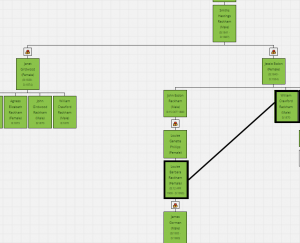
Early life
William Crawford Rackham was born in 1869 in Stratford on Avon, England. From the 1881 census and transcript we can see William Crawford Rackham aged 11 living in Stratford Upon Avon at 8 High Street (Drapers shop) with:
• His father Smith Hastings Rackham (aged 40) employing 5 drapers assistants , born in East Dereham Norwich
• His mother Jessie Rackham (aged 35) born in Stirlingshire in Scotland
• Sister Agnes Elizabeth Rackham (aged 8)
• Brother Smith Hastings Rackham (aged 3)
• Brother John Esdon Rackham
• Sister Jane Esdon Rackham (aged 1)
Canadian Special Forces Boer War
William served in the 2nd Strathcona’s Horse Regiment of the Canadian Special Forces services in South Africa 1899-1900, the Boer War extending between 1899 and 1902 with units serving from the British Army, Royal Navy and colonial forces who took part (Australia, Canada, New Zealand, India and South Africa). The Strathcona regiment was unusual!
The movement of the unit explains the movements of William Crawford, i.e. out of Ottawa, to South Africa and then back to London to receive the Queen’s Medal enroute back to Canada.
In William’s record it says he was awarded the Queen’s Medal with three clasps: Belfast, Natal and Orange Free States (Doc 1 & Doc 1a).
The Queen’s South Africa Medal (QSA) was awarded to military personnel who served in the Boer War in South Africa between 11 October 1899 and 31 May 1902 and was awarded to units from the British Army, Royal Navy, colonial forces who took part (Australia, Canada, New Zealand, India and South Africa), civilians employed in official capacity and war correspondents. William Crawford Rackham got three clasps as follows:
• ORANGE FREE STATE – 28 February 1900 – 31 May 1902
• BELFAST – Awarded to troops who, on 26 or 27 August 1900, were east of a north and south line drawn through Wonderfonein, and west of a north and south line through Dalmanutha Station, and north of an east and west line drawn through Carolina (Transvaal)
• NATAL – 11 October 1899 and 11 June 1900
William was discharged on the 16th March 1901 in Ottawa, his recruitment and discharge record makes interesting reading
Hudson Bay Company (from the Archives of Manitoba website)
William Crawford Rackham (b.1869) began his career with Hudson Bay Company in the Athabasca District as general help at Lesser Slave Lake (1902-1903) . In 1903, Rackham was transferred to Fort Vermillion, where he worked as a clerk for nine years until 1911. In the summer of 1911 he was made an accountant at Chipewyan with supervision of Fond du Lac and Fort McKay. He was then appointed inspecting clerk for the Athabasca District (1912-1915) and inspecting officer for the Keewatin District (1916-1918). In 1918 he became a District Manager stationed in the James Bay District where he remained until his resignation on 31 May 1921.
William Rackham was married by the time he left the Hudson Bay Company. He lived at Fort Alexander, Manitoba, from as early as 1926 and as late as 1939. There he fished, farmed and developed his property. His date of death is not known. He did receive a medal for 15 years service with the Hudson Bay Company along with a medal commemorating the 250th Anniversary of the Company.
While he was an employee of the Hudson Bay Company he took a lot of photographs as he travelled around Canada, which is why William has a record and collection of his own in the Archives of Manitoba. Details of this record were obtained from a lady called Anna Shumilak at the Archives, which includes 222 photographs taken on his travels, his personal diary and a separate photo album donated by J.G.M. Christie (who likely travelled with him while working in the Fur Trade Department). The photographic collection was presented to the Archives by Carl S. Simonson of Winnipeg in 1965 (1965-57). The photographs include scenes from both the Athabasca and Keewatin Districts (i.e. northern Alberta and Manitoba). They were presumably taken when Rackham was Inspecting Clerk in Athabasca (1912-15) and Inspecting Officer in Keewatin (1915-18)
Copies of the photographs are available at cost – three requested are shown below, amazing quality, but some of the names of the remaining that i havent got copies of are intriguing: ‘Boat going over rapids’, ‘Teepee at God’s Lake, ‘Canoes on Hairy Lake’, ‘Beaver Indians on the Peace River’, ‘Group of five people having a cup of tea along a river bank during winter’, ‘Cree Indian camp near the Peace River, drying moose meat’, ‘Man displaying a 28 pound lake trout’, ‘Slavery Indians at Fort Vermillion post’, ‘Iceberg in the North Atlantic Ocean’, and ‘boy and bear cub playing’. This is proper pioneer stuff!
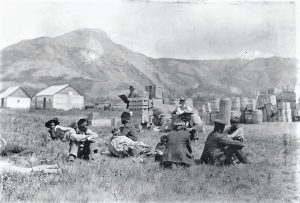
Hudson Bay Company Peace River – taken by William Crawford Rackham c 1902
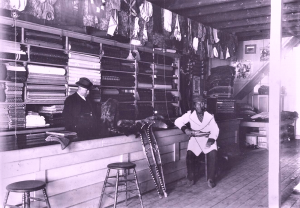
Hudson Bay Company Interior of store – taken by William Crawford Rackham 1910
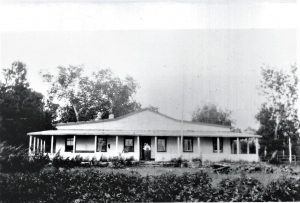
Hudson Bay Company Rackham House – taken by William Crawford Rackham no date
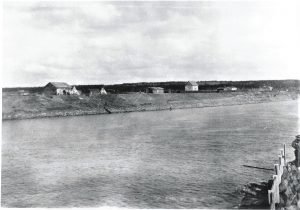
Hudson Bay Company Wolverine Point in the Peace River – taken by W.C.Rackham 1910
Next Steps
So many questions to follow up if anyone is interested…
- When did he come to Canada (are their sailing records available?)
- What happened to William after he left the HBC?
- Can we get hold of his diary from the Archives of Manitoba for a read?
- Who were his wife and children? Did they stay in Canada? Did Michael Gorman ever walk past the children in the street when they were in Canada (in Edmonton) in the 60’s?
- What sort of a life was it in the Hudson Bay Company?
- What’s the story behind the Slavery Indians?
- Will England ever win the World Cup?

Leave A Comment